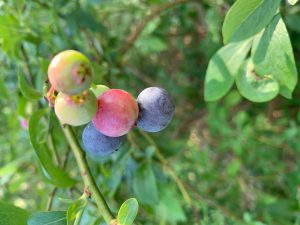
by Ginny Hinton | Jun 4, 2019
America’s favorite superfood is ripe in the Florida Panhandle! Well, it may not actually be everyone’s favorite, but it’s definitely a tasty superfood. Of course, I’m talking about the blueberry. If you love the sweet nutritious little blue fruit, now is the time to pick or purchase fresh from a local source.

Blueberries: Spectacular, Summer, Superfood
Photo source: Ginny Hinton
When it comes to antioxidants, blueberries are king. Antioxidants help protect our bodies from oxidative stress, which is linked to many diseases including arthritis, heart disease, stroke, and high blood pressure. They also help strengthen our immune system. Blueberries have one of the highest antioxidant levels of all common fruits and vegetables.
Blueberries are high in fiber (about 4 grams per serving), vitamin C and vitamin K. Of course, they’re also low in calories. Blueberries are available fresh in the Panhandle from late May into June.
When you’re picking blueberries, look for ones that are firm, dry, plump and smooth-skinned with a light greyish bloom. Stick to the deep blue ones for the sweetest flavor. Cover them and they’ll stay fresh in the refrigerator for up to ten days, or they can be easily frozen. Put them in a single layer on a baking sheet or cookie tray and freeze, then store them in airtight, resealable plastic bags. That way, they won’t stick together and you can use just the amount you need. Once you thaw them out, just be sure to use them within three days. Store blueberries unwashed and don’t rinse them until you’re ready to use them.
Don’t love to eat them plain? Nutritious, delicious blueberries are great in lots of dishes. For a quick breakfast or snack, add them to yogurt or cottage cheese and enjoy! Use them to flavor pancakes, waffles or muffins. Add them to a green salad for a sweet flavor burst. However you eat them, know that you’re doing a good thing for both your health and your taste buds.
Enjoy blueberries!

by Amy Mullins, PhD, RDN | May 31, 2019

Stay hydrated this summer.
Nothing is more refreshing on a hot summer day than an ice-cold glass of water! Water is an essential component to good health. In fact, it makes up 60% of your body’s weight and is involved in various metabolic processes throughout your body. Without it, you could not survive. As summer approaches, it is important to be mindful of the increasing temperatures outside since the chances for dehydration are much greater than other times of the year – especially if you are planning to spend a lot of time outdoors.
Dehydration happens when your body lacks enough water to carry out normal processes. It often occurs when you are expending more water (usually through sweat & exercise) than you are consuming, and is accelerated in warm humid climates. Dehydration is no joke, and can lead to serious medical complications such as heat stroke, heat stress, and even death. Common signs and symptoms that may indicate you are dehydrated include fatigue, headache, dry mouth, little to no urination, constipation, vomiting, muscle-weakness, dizziness, and lightheadedness. Most susceptible to heat stress and complications from dehydration include infants, older adults (65 & up), people who are overweight, and people who are excessive sweaters during physical activity. If you fall into any of those categories, try to be mindful about how much fluid you are consuming throughout the day.
How can you prevent dehydration?
While many people think they may be drinking enough, that is often not the case. Your own thirst mechanism isn’t always the best gauge to make sure you are properly hydrated. According to the National Academy of Medicine, women should consume an average of 9 ½ cups of water per day and men should be consuming 12 cups. For older adults over the age of 70, the rule of thumb is about 7 cups per day. That includes all fluids from water, coffee, and juices.
Keep in mind that needs may be different for each of us. One simple way to check your hydration status is to look at the color of your urine. If the color of your urine is a light lemonade color, you are in the clear! However, if your urine color is a dark orange, you need to start drinking some fluids to get back to a hydrated state to avoid any health complications.
Additional ways to reach your fluid intake without refilling your water bottle
Did you know water makes up the largest component of many of the foods we eat? By adding some more fruits and vegetables to your diet such as watermelon, strawberries, melons, oranges, broccoli, bell peppers, and lettuces – you are not only increasing your fluid intake but getting your necessary vitamins and minerals as well! According to the Dietary Guidelines for Americans, people should be consuming an average of 2 cups of fruits and vegetables per day.
Other factors that can influence your hydration status
Alcohol – Alcohol acts as a diuretic – meaning it turns down a hormone called antidiuretic hormone (ADH) which tells your kidneys to absorb/retain fluids. In other words, drinking a lot of alcohol will make you expel more fluids from your body. Make sure to drink extra water while enjoying alcoholic beverages to avoid becoming dehydrated.
Diet – Consuming a high-sodium diet is another cause of dehydration. Sodium is necessary in our diets, but only in very small amounts. When we consume excessive amounts of sodium, this disrupts the body’s filtration system and the kidneys begin holding onto more and more water. This leads to dehydration, bloating, edema, hypertension, and cardiovascular stress. Drinking extra water can help bring things back into balance and re-hydrate your thirsty cells!
Older Age – As we get older, thirst sensations decrease and risk for dehydration increases since older adults do not feel the need to drink as much. Additionally, many medications can influence fluid needs in the body.
Caffeine – Contrary to popular belief, caffeine does not dehydrate you. When you drink coffee, or other caffeinated beverages you are also consuming fluids. High fluid consumption leads to higher frequency of urination.
Learn to LOVE Water
Water by itself can definitely get old if it isn’t your beverage of choice. There are plenty of ways to add flavor and sweetness to your drinks without packing in tons of extra calories and sugar. Fruit infusions are a very simple way to make a boring beverage much more delicious. Try some of these delightful, thirst-quenching recipes!
Raspberry Orange Mint
- Water
- 1 cup raspberries
- 1 orange sliced up
- Mint leaves
Lemon Lime Thyme
- Water
- 1 lemon sliced
- 1 lime sliced
- 1 large sprig of fresh thyme
Blueberry Lemon Mint
- Water
- 1 cup blueberries
- 1 lemon sliced

by Angela Hinkle | May 6, 2019
Spring has sprung! Have you? One way to shake off those groggy winter hibernation feelings is to Put a Little Step In Your Spring.
Regular Brisk Walking
- Means you can talk but maybe not sing. You may be slightly out of breath.
- Improves overall health.
- Can help you maintain a healthy weight.
- Prevents chronic health conditions including heart disease, high blood pressure, and type 2 diabetes.
- Strengthens bones.
- “Boosts” or increases muscle power and endurance.

Ready to walk to the top (of Mt Vesuvius) Photo Source: Richard Waid
Strive for 10,000 Steps a Day
- Spring clean your house.
- Mow the lawn.
- Dance around your living room.
- Take the stairs.
- Park in the farthest spot in the parking lot from your destination.
- Wear a pedometer or electronic fitness device to measure how many steps you’ve gone.
- Try for at least 30 minutes a day. If you can’t – break up your walking into smaller segments.
- Vary your intensity – speed up, slow down. Then repeat.
- Vary the view. Try different settings to walk – your neighborhood, the beach, or the woods.
Make It Social
- Let your dog take you for a walk. (Be sure to bring cleanup bags with you and have your best friend(s) on a leash.)
- Walk with friends.
- Make it a family routine.
- Join a walking club.
- Compete with a group to see who can get the most steps.
- Walk in the mall or a park. And say hello to people as you pass by.
- Mindful walk – notice the colors around you, how your feet feel as they step down on different surfaces, the variety of sounds you hear on your walk. Meet someone along the way. Learn their name…and remember it. For info on mindfulness, check out this UF/IFAS publication: Mindfulness: An Introduction.
Always remember to walk in a safe environment, wear comfortable walking shoes, and check with your medical provider for the best walking strategies for you.
So this spring, see how the flowers pop in color. Hear all the different sounds the birds make or enjoy some of your favorite music. Feel the wind and sun on your face. You can do all that and more when you Put a Little Step in Your Spring.

by Angela Hinkle | Feb 8, 2019
Do you know what the different types of cholesterol are in your body? Do you know what your cholesterol levels are? Do you know why your numbers matter? Cholesterol can be a contributing factor to heart disease. It’s important to understand your numbers so you can take the best care of yourself. Making simple changes in your daily routine can help reduce your risk of heart disease. Talking to your doctor is the first step so he or she can request blood tests to help determine your risk. One of the tests the doctor may run is called a lipid profile, which checks your body’s cholesterol.
What should my cholesterol numbers be?
- Total cholesterol should be somewhere between 125 to 200 mg/dL
- LDL cholesterol is called “bad” because it can block your arteries. The level should be less than 100 mg/dL. If it starts with “L”, aim for a lower number.
- HDL cholesterol is called “good” because it helps to clear out the LDL (bad) cholesterol. This number should be greater than 40 mg/dL for men and greater than 50 mg/dL for women. If it starts with “H”, aim for a higher number.
- Triglycerides are fat found in the blood. You want these numbers to be less than 150 mg/dL.
If you don’t understand what your numbers mean, be sure to talk with your health care provider. The more you know about your numbers, the more incentive you have to make any recommended changes.
What Can Cause Unhealthy Levels of Cholesterol?
- Habits like smoking, lack of physical activity, and unhealthy eating patterns.
- Genetics (family medical history)
- Some medications

Prepping for a healthy diet
Photo source: UF/IFAS
What Can You Do to Help Lower the “Bad” Cholesterol and Increase the “Good” Cholesterol?
You can make simple changes to your daily routine to help reduce your risk of heart disease.
Eat more heart-healthy foods
- Eat foods like oatmeal, apples, and pears to give your body more soluble fiber.
- Add salmon, walnuts, and flaxseed to your diet. These are great sources of Omega-3 fatty acids.
- Eat less red meat and switch from whole or 2% milk to skim milk.
Move!
- The Mayo Clinic recommends 30 minutes of exercise at least 5 times a week.
- Find out more about how to fit physical activity into your day
Stop Smoking!
- There are many different resources available to help you or someone you know quit smoking.
- Check out how to quit for quitting tobacco tips from A to Z
Drop those extra pounds
- If you lose just 5% of your body weight, it can help your heart!
- See what a 5% weight loss can do for your health
By making simple changes to your diet and lifestyle, you can help to reduce the risk of heart disease. Change takes time and effort, so don’t get discouraged by trying to make all the changes at once! Pick one habit to work on, such as slowly switching from whole milk to 2% to 1% then finally to skim milk. Once drinking skim milk becomes part of your everyday routine, choose another habit to work on, such as getting more exercise. Adding a half hour walk in the morning or in the evening is a great way to get you moving. To make the walk even more enjoyable, take your dog with you – pets need exercise, too!
Your good health is why your numbers matter. Remember, small changes can make a big difference in improving your heart health. And since February is Heart Health Awareness month, now is a great time to start.
Contributing writer – UF Intern Jennifer Bryson

by Melanie Taylor | Jan 18, 2019

Be mindful and enjoy the moment.
Photo source: UF/IFAS Northwest District
Now that the busy holiday season is over, it is time not only to reflect on the past, but to prepare and refocus for the New Year ahead. As we focus on the New Year, it is always refreshing to have a clean slate. As the year begins to unfold, there are tips to help you manage your day-to-day stress levels. It begins with mindfulness.
What is mindfulness? Mindfulness means paying attention in a particular way; on purpose, in the present moment, and nonjudgmentally.” –Dr. Jon Kabat-Zinn (1991)
Mindfulness is best thought of as a way of being rather than an activity in and of itself. Almost any activity can be carried out with mindful awareness.
Mindful awareness has three key features:
Purpose – mindfulness involves intentionally and purposefully directing your attention rather than letting it wander.
Presence – mindfulness involves being fully engaged with and attentive to the present moment. Thoughts about the past and future that arise are recognized simply as thoughts occurring in the present.
Acceptance – mindfulness involves being nonjudgmental toward whatever arises in the moment. This means that sensations, thoughts, and emotions are not judged as good or bad, pleasant or unpleasant; they are simply noticed as “happening,” and observed until they eventually pass (Naik, Harris, and Forthun 2016).
Mindfulness is a mind-body practice that has been found to benefit both psychological and physical health. The primary psychological change that occurs during mindfulness practice is an increased awareness of thoughts, feelings, and sensations in the present moment. Over time, mindfulness practice can help you to become aware of the space between noticing experiences and reacting to them by letting you slow down and observe the processes of your mind (Black 2010). The ultimate goal of mindfulness practice is for you to take advantage of this space so you can make more intentional decisions – to wake up from living life on autopilot, based on unproductive habits of mind (Black 2010; Walach et al. 2007).
According to the American Psychological Association, some empirically supported benefits of mindfulness include the following (Davis & Hayes 2011):
Psychological Benefits
Increased awareness of one’s mind
Significantly reduced stress, anxiety, and negative emotions
Increased control over ruminative thinking (a major cause and symptom of depression and anxiety)
Increased mental flexibility and focus
More working memory
Decreased distracting thoughts
Decreased emotional reactivity
Increased capacity for intentional, responsive behaviors
Increased empathy, compassion and conscientiousness of others’ emotions
Physiological Benefits
Enhanced immune system functioning
Increased brain density and neural integration in areas responsible for positive emotions, self-regulation, and long-term planning
Lowered blood pressure
Lowered levels of blood cortisol (a major stress hormone)
Greater resistance to stress-related illnesses such as heart disease
Spiritual Benefits
Increased self-insight and self-acceptance
Increased acceptance of others
Increased compassion and empathy
Increased sense of morality, intuition, and courage to change
Increased control over automatic behaviors
Increased self-discipline
The question is: how many of us would like to benefit from mindfulness if it provides these positive benefits? All of us should strive to lower our stress level and enjoy our daily lives with a more positive attitude and more attentiveness. So, how can we incorporate this into our lives? The majority of this practice is about familiarizing yourself with what it feels like to be mindful, and getting better at “remembering” to maintain mindful awareness.
Experiment with creating your own mindfulness practices throughout your day. Being mindful of the sensation on the soles of your feet as you walk to your car or the taste and texture of your morning coffee can transform routine moments into deeply satisfying practices. However, having a ritualized and structured practice can be beneficial. To find out more about practicing mindfulness and how to incorporate a more structured practice in your life visit http://edis.ifas.ufl.edu, Publication # FCS2335 – Mindfulness: An Introduction.
Source: Mindfulness: An Introduction. http://edis.ifas.ufl.edu. Publication # FCS2335.










